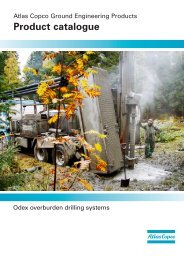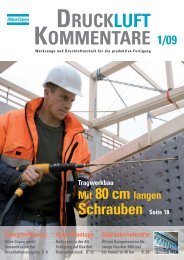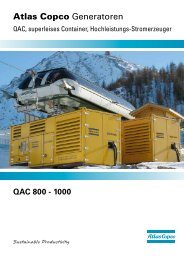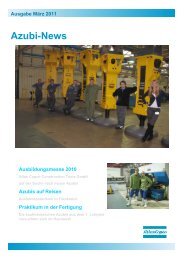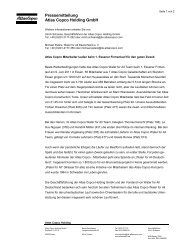- Page 1 and 2: Industrial Power Tools 2010-11 The
- Page 3 and 4: 2 Whatever your business, we can ad
- Page 5 and 6: 4 Our commitment to your productivi
- Page 7: 6 Quality, every step of the way At
- Page 11 and 12: 10 Your guide to the catalogue Acce
- Page 13 and 14: Pneumatic Assembly Tools Introducti
- Page 15 and 16: Pneumatic Screwdrivers Introduction
- Page 17 and 18: Pneumatic Screwdrivers Pistol Grip
- Page 19 and 20: Pneumatic Screwdrivers Pistol Grip
- Page 21 and 22: Pneumatic Screwdrivers Straight Mod
- Page 23 and 24: Pneumatic Screwdrivers Angle Models
- Page 25 and 26: Pneumatic Screwdrivers Accessories
- Page 27 and 28: Impact Wrenches Selection Guide =
- Page 29 and 30: Impact Wrenches Pistol Grip Models
- Page 31 and 32: Impact Wrenches Accessories LMS, LT
- Page 33 and 34: Impact Wrenches Accessories LMS, LT
- Page 35 and 36: Hydraulic Impulse Nutrunners Select
- Page 37 and 38: Hydraulic Impulse Nutrunners Pistol
- Page 39 and 40: Hydraulic Impulse Nutrunners Straig
- Page 41 and 42: Hydraulic Impulse Nutrunners Access
- Page 43 and 44: Controlled Impulse Nutrunners Intro
- Page 45 and 46: Controlled Impulse Nutrunners Acces
- Page 47 and 48: Pneumatic Nutrunners Introduction -
- Page 49 and 50: Pneumatic Nutrunners Angle Nutrunne
- Page 51 and 52: Pneumatic Nutrunners Angle Nutrunne
- Page 53 and 54: Pneumatic Nutrunners Angle Nutrunne
- Page 55 and 56: Pneumatic Nutrunners Accessories An
- Page 57 and 58: Pneumatic Nutrunners Accessories An
- Page 59 and 60:
Pneumatic Nutrunners Accessories An
- Page 61 and 62:
Pneumatic Nutrunners Accessories An
- Page 63 and 64:
Fast, flexible and user-friendly Th
- Page 65 and 66:
Shut-off Straight Nutrunners Air Re
- Page 67 and 68:
Straight Nutrunners Accessories Opt
- Page 69 and 70:
Non Shut-off Pistol Grip Nutrunners
- Page 71 and 72:
Shut-off Pistol Grip Nutrunners For
- Page 73 and 74:
Pistol Grip Nutrunners Accessories
- Page 75 and 76:
Battery Assembly Tools Contents Pag
- Page 77 and 78:
Powerful, durable and highly operat
- Page 79 and 80:
BCP Accessories Optional Accessorie
- Page 81 and 82:
BTV Accessories Optional Accessorie
- Page 83 and 84:
Tensor STB Nutrunners - Transduceri
- Page 85 and 86:
ETO STB Tensor STB Tube Nut In-Line
- Page 87 and 88:
Electric Assembly Tools and Systems
- Page 89 and 90:
Safety Atlas Copco wants everyone t
- Page 91 and 92:
Brushless clutch type EBL Designed
- Page 93 and 94:
ETD, ETF MicroTorque Ultra low-torq
- Page 95 and 96:
MicroTorque Accessories Vacuum adap
- Page 97 and 98:
ETD SL l ETD SL is a very compact s
- Page 99 and 100:
Tensor Accessories Optional Accesso
- Page 101 and 102:
Tensor Accessories Optional Accesso
- Page 103 and 104:
Electric Nutrunners Tensor Overview
- Page 105 and 106:
Tensor DS Straight Models ETD DS l
- Page 107 and 108:
Tensor DS Pistol Grip Models ETP DS
- Page 109 and 110:
Tensor DS Tube Nut In-Line tube nut
- Page 111 and 112:
Tensor S Straight Models ETD S l ET
- Page 113 and 114:
Tensor ST Angle Models ETV ST l ETV
- Page 115 and 116:
Tensor ST Angle Models Square drive
- Page 117 and 118:
Tensor ST Straight Models Square dr
- Page 119 and 120:
Tensor ST Crowfoot In-Line crowfoot
- Page 121 and 122:
Tensor STR Angle Models ETV STR l S
- Page 123 and 124:
Tensor Accessories Optional Accesso
- Page 125 and 126:
Tensor Accessories Optional Accesso
- Page 127 and 128:
Tensor Accessories Optional Accesso
- Page 129 and 130:
Introduction - Controllers and Soft
- Page 131 and 132:
DS/DL Drive Controllers Drive funct
- Page 133 and 134:
Power Focus 4000 series Controllers
- Page 135 and 136:
Introduction - Quality Integrated F
- Page 137 and 138:
Quality Integrated Fastening Statio
- Page 139 and 140:
Quality Integrated Fastening Statio
- Page 141 and 142:
Tool Accessories Contents Page Torq
- Page 143 and 144:
SM A2 Parallel Arm SM A2 - Parallel
- Page 145 and 146:
SML Linear Arm SML - Linear torque
- Page 147 and 148:
GHP Torque Arms MicroTorque GHP - T
- Page 149 and 150:
Optional Accessories for SM A2 and
- Page 151 and 152:
Optional Accessories for GHP MicroT
- Page 153 and 154:
Torx bits Application: For Torx scr
- Page 155 and 156:
TorxPlus bits Application: For Torx
- Page 157 and 158:
Power socket 3/4" square drive 3/4"
- Page 159 and 160:
Fixtured Applications Contents Page
- Page 161 and 162:
Nutrunners to match your needs The
- Page 163 and 164:
QST Fixtured Nutrunners Travel Torq
- Page 165 and 166:
QST Accessories Optional Accessorie
- Page 167 and 168:
ETX Accessories Optional Accessorie
- Page 169 and 170:
Power MACS 4000 Controllers Power M
- Page 171 and 172:
System Guide Controllers Easy-to-bu
- Page 173 and 174:
Power Focus 4000 series Controllers
- Page 175 and 176:
Quality Assurance in Tightening Con
- Page 177 and 178:
ACTA 400 Torque Readouts ACTA 400 T
- Page 179 and 180:
QRTT/IRTT-B Transducers QRTT Trandu
- Page 181 and 182:
MRTT-B Transducers MRTT-B Manual wr
- Page 183 and 184:
MicroTorque Accessories Torque anal
- Page 185 and 186:
STwrench Functionality Overview Fun
- Page 187 and 188:
STwrench Accessories IRC Modules Tw
- Page 189 and 190:
600 - 700 B A H B H L L 600 - 700 W
- Page 191 and 192:
JSB Test Benches BLM Joint Simulato



